
York is the oldest inland town in Western Australia, situated on the Avon River, 97 kilometres (60 mi) east of Perth in the Wheatbelt, on Ballardong Nyoongar land, and is the seat of the Shire of York.

The Diocese of Ballarat is a diocese of the Anglican Church of Australia, which was created out of the Diocese of Melbourne in 1875. It is situated in the Ballarat region of the state of Victoria, Australia and covers the south-west region of the state. The diocesan cathedral is the Cathedral of Christ the King in Ballarat. Garry Weatherill, formerly the Bishop of Willochra between 2000 and 2011, was installed as the 10th Bishop of Ballarat on 5 November 2011.

The Rosewater Uniting Church was founded in Queenstown, South Australia as a Primitive Methodist Church in 1878. The Foundation Stone was laid by the Chairman of the Rosewater District Council, Mr. H.C.E. Muecke on 10 August, and the opening services were held on 24 November 1878.

The Durham Street Methodist Church in Christchurch was the earliest stone church constructed in the Canterbury region of New Zealand. It is registered as a "Historic Place – Category I" by Heritage New Zealand.

Trinity Church is a Uniting church located at 72 St Georges Terrace in Perth, Western Australia. Commenced in 1893, the former Congregational church is one of the oldest church buildings in the City of Perth, and one of the few remaining 19th-century colonial buildings in the city.
The Reverend John Smithies (1802–1872) was a Wesleyan Methodist missionary who served in Newfoundland, the Swan River Colony of Western Australia, and Tasmania.

Wesley Uniting Church is a heritage-listed former Uniting church at 54 Neil Street, Toowoomba, Toowoomba Region, Queensland, Australia. It was designed by Willoughby Powell and built from 1877 to 1924. It is also known as Wesleyan Methodist Church. It was added to the Queensland Heritage Register on 10 May 1997.

Surface Hill Uniting Church is a heritage-listed former Uniting church at Channon Street, Surface Hill, Gympie, Gympie Region, Queensland, Australia. It was designed by architect Hugo William Du Rietz and built from 1869 to 1937. It is also known as City Church, Surface Hill Methodist Church and Wesleyan/Wesley Church. It was added to the Queensland Heritage Register on 30 May 2003.

Pilgrim Uniting Church is a church in the heart of the City on Flinders Street, Adelaide in South Australia. It is a church of the Uniting Church in Australia.
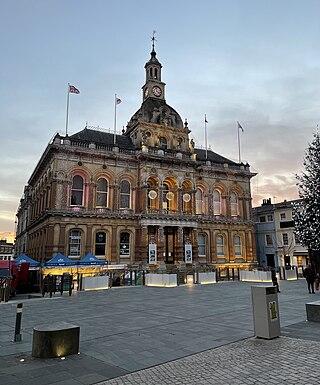
Bellamy and Hardy was an architectural practice in Lincoln, England, that specialised particularly in the design of public buildings and non-conformist chapels. Pearson Bellamy had established his own architectural practice by 1845 and he entered into a partnership with James Spence Hardy in June 1853. Both partners had previously worked for the Lincoln architect William Adams Nicholson. Hardy was described as "Chief Clerk" to Nicholson. Hardy joined Pearson Bellamy immediately after the sudden death of Nicholson. As all known architectural drawings by the practice are signed Pearson Bellamy, it is likely that Bellamy was the architect and Hardy was the administrator in the practice. The partnership lasted until 1887 After this Bellamy continued to practice until 1896.

Clayton Wesley Uniting Church, formerly Clayton Congregational Church, is a Uniting church, located at 280 Portrush Road, Beulah Park, Adelaide, South Australia, Australia. The current building with its tall spire was built was built in 1883, although an earlier building, behind the present church and now known as the Lecture Hall, was built in 1856. The church is located in a commanding position at the eastern end of The Parade, Norwood.

Avon Terrace it is the main street of the town of York, Western Australia, and is lined with heritage buildings.

Holy Trinity Church is a heritage-listed Anglican church on the corner of Newcastle and Pool Streets, in York, Western Australia. The church was consecrated in 1858 by the first Anglican Bishop of Perth, Mathew Blagden Hale.
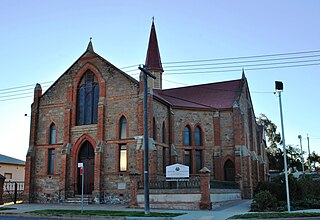
Wesley Uniting Church is a heritage-listed Uniting church at Cobalt Street, Broken Hill, City of Broken Hill, New South Wales, Australia. It was designed by Frederick William Dancker and built from 1885 to 1888 by Messrs. Walter and Morris. It is also known as Wesley Uniting Church and Hall Group, Wesleyan Uniting Church Group, Wesley Church and Wesley Hall. The property is owned by the Uniting Church in Australia. It was added to the New South Wales State Heritage Register on 23 April 2010 and on the Australian Register of the National Estate.

Faversham House is a heritage-listed "grand residence" overlooking Avon Terrace in York, Western Australia. The house, named after the birthplace of John Henry Monger Snr, was built in four stages by the Monger family.
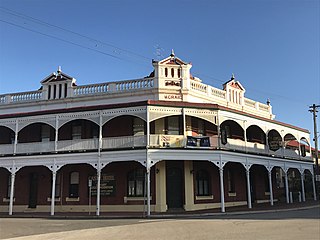
The Castle Hotel in York is one of the oldest surviving hotels in Western Australia. Its first proprietor was Samuel Craig and it was then held by members of the Craig family for 137 years.
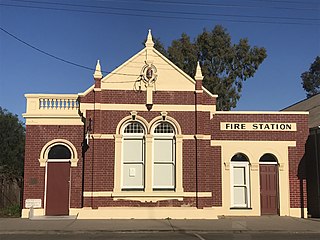
The York Fire Station is a single-storey red brick building originally constructed for the York Municipal Council as Council Chambers in 1897, in York, Western Australia.
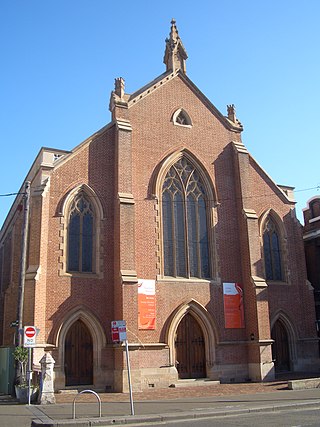
The Newtown Mission Uniting Church is a heritage-listed Uniting church at 280a King Street, Newtown, City of Sydney, New South Wales, Australia. It was designed by George Allen Mansfield and built in 1859 by Thomas Abbott. It was added to the New South Wales State Heritage Register on 2 April 1999.
John Henry Monger Snr (1802–1867) arrived in Western Australia as an assisted migrant in 1829. After a short period running a mill at what became Lake Monger, he established a hotel and store in York and went on to become one of the richest men in the colony.
Joseph Pyke (1831-1910) was a shoemaker who settled in York, Western Australia in 1857 with his wife, Elizabeth, and became a prominent store keeper and land owner in the town, developing the first street-front shops, and taking a significant role in town affairs.



















